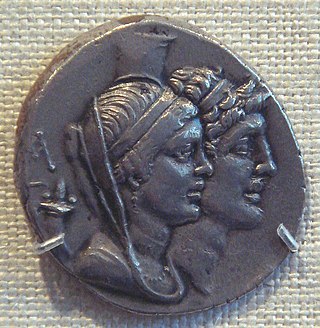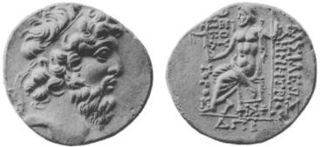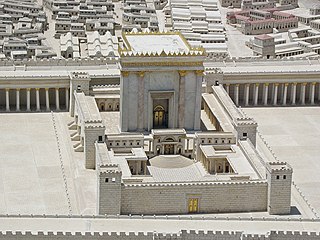Related Research Articles

Alexander I Theopator Euergetes, surnamed Balas, was the ruler of the Seleucid Empire from 150 BC to August 145 BC. Picked from obscurity and supported by the neighboring Roman-allied Kingdom of Pergamon, Alexander landed in Phoenicia in 152 BC and started a civil war against Seleucid King Demetrius I Soter. Backed by mercenaries and factions of the Seleucid Empire unhappy with the existing government, he defeated Demetrius and took the crown in 150 BC. He married the princess Cleopatra Thea to seal an alliance with the neighboring Ptolemaic kingdom. His reign saw the steady retreat of the Seleucid Empire's eastern border, with important eastern satrapies such as Media being lost to the nascent Parthian Empire. In 147 BC, Demetrius II Nicator, the young son of Demetrius I, began a campaign to overthrow Balas, and civil war resumed. Alexander's ally, Ptolemaic king Ptolemy VI Philometor, moved troops into Coele-Syria to support Alexander, but then switched sides and threw his support behind Demetrius II. At the Battle of the Oenoparus River in Syria, he was defeated by Ptolemy VI and he died shortly afterward.

The Seleucid Empire was a Greek power in West Asia during the Hellenistic period. It was founded in 312 BC by the Macedonian general Seleucus I Nicator, following the division of the Macedonian Empire founded by Alexander the Great, and ruled by the Seleucid dynasty until its annexation by the Roman Republic under Pompey in 63 BC.

The 2nd century BC started the first day of 200 BC and ended the last day of 101 BC. It is considered part of the Classical era, although depending on the region being studied, other terms may be more suitable. It is also considered to be the end of the Axial Age. In the context of the Eastern Mediterranean, it is the mid-point of the Hellenistic period.
This article concerns the period 159 BC – 150 BC.
This article concerns the period 169 BC – 160 BC.
Year 150 BC was a year of the pre-Julian Roman calendar. At the time it was known as the Year of the Consulship of Flamininus and Balbus. The denomination 150 BC for this year has been used since the early medieval period, when the Anno Domini calendar era became the prevalent method in Europe for naming years.
Year 160 BC was a year of the pre-Julian Roman calendar. At the time it was known as the Year of the Consulship of Gallus and Cethegus and the Fourth Year of Houyuan. The denomination 160 BC for this year has been used since the early medieval period, when the Anno Domini calendar era became the prevalent method in Europe for naming years.
Year 162 BC was a year of the pre-Julian Roman calendar. At the time it was known as the Year of the Consulship of Corculum/Lentulus and Figulus/Ahenobarbus and the Second Year of Houyuan. The denomination 162 BC for this year has been used since the early medieval period, when the Anno Domini calendar era became the prevalent method in Europe for naming years.
Year 164 BC was a year of the pre-Julian Roman calendar. At the time it was known as the Year of the Consulship of Torquatus and Longinus. The denomination 164 BC for this year has been used since the early medieval period, when the Anno Domini calendar era became the prevalent method in Europe for naming years.

Demetrius I, surnamed Soter, reigned as king (basileus) of the Hellenistic Seleucid Empire from November 162 to June 150 BC. Demetrius grew up in Rome as a hostage, but returned to Greek Syria and overthrew his young cousin Antiochus V Eupator and regent Lysias. Demetrius took control during a turbulent time of the Empire, and spent much of his time fighting off revolts and challenges to his power from threats such as Timarchus and Alexander Balas.

Antiochus IV Epiphanes was a Greek Hellenistic king who ruled the Seleucid Empire from 175 BC until his death in 164 BC. He was a son of King Antiochus III the Great. Originally named Mithradates, he assumed the name Antiochus after he ascended the throne. Notable events during Antiochus's reign include his near-conquest of Ptolemaic Egypt, his persecution of the Jews of Judea and Samaria, and the rebellion of the Jewish Maccabees.

Cleopatra I or Cleopatra Thea, surnamed Eueteria was a ruler of the Hellenistic Seleucid Empire. She was queen consort of Syria from 150 to about 125 BC as the wife of three Syrian kings: Alexander Balas, Demetrius II Nicator, and Antiochus VII Sidetes. She ruled Syria from 125 BC after the death of Demetrius II Nicator, eventually in co-regency with her son Antiochus VIII Grypus until 121 or 120 BC.

The Hasmonean dynasty was a ruling dynasty of Judea and surrounding regions during the Hellenistic times of the Second Temple period, from c. 140 BCE to 37 BCE. Between c. 140 and c. 116 BCE the dynasty ruled Judea semi-autonomously in the Seleucid Empire, and from roughly 110 BCE, with the empire disintegrating, Judea gained further autonomy and expanded into the neighboring regions of Perea, Samaria, Idumea, Galilee, and Iturea. The Hasmonean rulers took the Greek title basileus ("king") as the kingdom became a regional power for several decades. Forces of the Roman Republic intervened in the Hasmonean Civil War in 63 BCE and made it into a client state, marking the decline of Hasmonean dynasty; Herod the Great displaced the last reigning Hasmonean client-ruler in 37 BCE.

Jonathan Apphus was one of the sons of Mattathias and the leader of the Hasmonean dynasty of Judea from 161 to 143 BCE.

The Battle of the Oenoparus took place in 145 BC on the Oenoparus river in the adjoining countryside of Antioch on the Orontes, the capital of the Seleucid Empire. It was fought between a coalition of Ptolemaic Egypt led by Ptolemy VI and Seleucids who favored the royal claim of Demetrius II Nicator against Seleucids who favored the claim of Alexander Balas. Both the Seleucid Empire and the Ptolemaic kingdom were diadochi, Greek-ruled successor states established after the conquests of Alexander the Great.

The Syrian Wars were a series of six wars between the Seleucid Empire and the Ptolemaic Kingdom of Egypt, successor states to Alexander the Great's empire, during the 3rd and 2nd centuries BC over the region then called Coele-Syria, one of the few avenues into Egypt. These conflicts drained the material and manpower of both parties and led to their eventual destruction and conquest by Rome and Parthia. They are briefly mentioned in the biblical Books of the Maccabees.

Laodice V was a Seleucid princess. Through marriage to Perseus king of Macedon she was a Queen of the ruling Antigonid dynasty in Macedonia and possibly later of the Seleucid dynasty.

The Seleucid Dynastic Wars were a series of wars of succession that were fought between competing branches of the Seleucid royal household for control of the Seleucid Empire. Beginning as a by-product of several succession crises that arose from the reigns of Seleucus IV Philopator and his brother Antiochus IV Epiphanes in the 170s and 160s, the wars typified the final years of the empire and were an important cause of its decline as a major power in the Near East and Hellenistic world. The last war ended with the collapse of the kingdom and its annexation by the Roman Republic in 63 BC.
Hellenistic Palestine is the term for the history of the region of Palestine during the Hellenistic period, when Achaemenid Syria was conquered by Alexander the Great and subsumed into his growing Macedonian empire. Following his death and the division of his empire among the Diadochi, the region came first under Ptolemaic rule beginning in the late 4th century BCE with Ptolemy I Soter, followed by Seleucid rule beginning in the early 2nd century BCE with Antiochus III the Great. Later the same century, the Maccabean revolt weakened the grip of the Seleucid Empire and paved the way for the emergence of the rule of the local Hasmonean dynasty. Following the 63 BCE Siege of Jerusalem by Pompey the Great, the region was annexed by the Roman Republic, marking the end of Hellenistic Palestine and the beginning of Roman Judea.

The Second Temple period in Judaism began with the end of the Babylonian captivity and the Persian conquest of the Near East in 539 BCE. The Second Temple was then built, and finished around 516 BCE. The conquests of Macedonia under Alexander the Great in 332 BCE saw Judea and the Near East placed under Greek influence during the Hellenistic period; Hellenistic Judaism blended both Greek and Jewish traditions. The Maccabean Revolt of 167–142 BCE was fight a first for Judean autonomy against a suppression of traditional Judaism, and later acquired outright independence under the rule of the Hasmonean family in an independent Hasmonean kingdom. The Hasmoneans would rule until 63 BCE, when they were reduced to client king status as Roman puppets; that too would end in 37 BCE, with King Herod the Great taking control, leading to the Herodian dynasty. Herod's death would lead to both the Herodian Tetrarchy where smaller regions ruled by members of his family, as well as direct Roman control by the governors of Roman Judea. The period would come to an end with the First Jewish–Roman War of 66–73 CE. Jerusalem was conquered in 70 CE, and the Second Temple was destroyed.